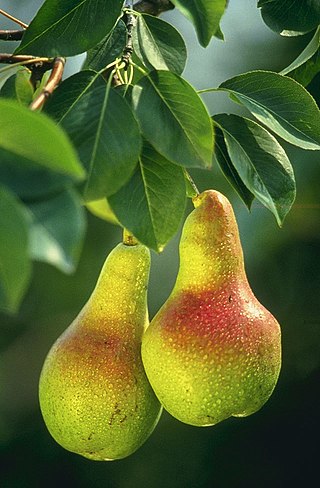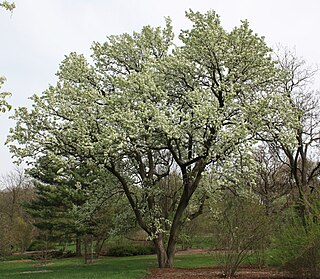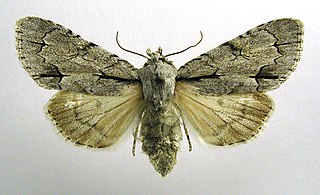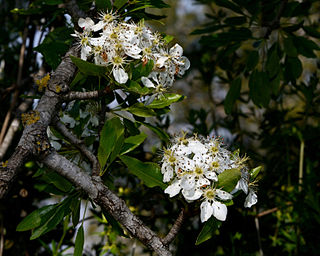
Pears are fruits produced and consumed around the world, growing on a tree and harvested in late summer into mid-autumn. The pear tree and shrub are a species of genus Pyrus, in the family Rosaceae, bearing the pomaceous fruit of the same name. Several species of pears are valued for their edible fruit and juices, while others are cultivated as trees.

Pyrus pyrifolia is a species of pear tree native to southern China and northern Indochina, and have been introduced to Korea, Japan and other parts of the world. The tree's edible fruit is known by many names, including Asian pear, Persian pear, Japanese pear, Chinese pear, Korean pear, Taiwanese pear, apple pear, zodiac pear, three-halves pear, papple, naspati and sand pear. Along with cultivars of P. × bretschneideri and P. ussuriensis, the fruit is also called the nashi pear. Cultivars derived from Pyrus pyrifolia are grown throughout East Asia, and in other countries such as India, Pakistan, Nepal, Australia, New Zealand, and the United States. Traditionally in East Asia the tree's flowers are a popular symbol of early spring, and it is a common sight in gardens and the countryside.

Pyrus × bretschneideri, the ya pear or pearple or Chinese white pear, is an interspecific hybrid species of pear native to North China, where it is widely grown for its edible fruit.

Pyrus calleryana, or the Callery pear, is a species of pear tree native to China and Vietnam, in the family Rosaceae. It is most commonly known for its cultivar 'Bradford' and its offensive odor, widely planted throughout the United States and increasingly regarded as an invasive species.

Pyrus communis, the common pear, is a species of pear native to central and eastern Europe, and western Asia.
A pear is a tree of the genus Pyrus and the fruit of that tree, edible in some species.

The dark dagger is a moth of the family Noctuidae. The species was first described by Michael Denis and Ignaz Schiffermüller in 1775. It is distributed throughout Europe, Turkey, the Near East, the European part of Russia, southern Siberia, the Ural, the Russian Far East, the Korean Peninsula, China and Japan (Hokkaido).

The D'Anjou pear, sometimes referred to as the Beurré d'Anjou or simply Anjou, is a short-necked cultivar of European pear. The variety was originally named 'Nec Plus Meuris' in Europe and the name 'Anjou' or 'd'Anjou' was erroneously applied to the variety when introduced to America and England. It is thought to have originated in the mid-19th century, in Belgium or France.

Pyrus nivalis, commonly known as yellow pear or snow pear, is a species of tree in the family Rosaceae that grows naturally from South-East Europe to Western Asia. Like most pears, its fruit can be eaten raw or cooked; it has a mild sour taste. The fruit is picked in October, when it is still dry and unripe; it will not become soft and sweet until the end of November or December, hence the name snow pear.

The Williams' bon chrétien pear, commonly called the Williams pear, or the Bartlett pear in the United States and Canada, is the most commonly grown variety of pear in most countries outside Asia.

The black Worcester pear is a cultivar of the European pear, it may have come to the UK via the Romans, but also has been used in heraldry and around the city of Worcester. The dark fruit is mainly used for cooking or culinary uses.

The flat peach, also known as the doughnut/donut peach or Saturn peach, is a variety of peach with pale yellow fruit that is oblate in shape.

Dangshan County is a county in the far north of Anhui Province, China. It is under the administration of Suzhou city. It is famous for fruits.

Pyrus pashia, the wild Himalayan pear, is a small to medium size deciduous tree of the small and oval shaped crown with ovate, finely toothed leaves, attractive white flowers with red anthers and small pear-like fruits. It is a fruit bearing tree that is native to southern Asia. Locally, it is known by many names such as batangi (Urdu), tangi (Kashmiri), mahal mol (Hindi) and passi (Nepal).

A Conference pear is a variety of pear.

Pyrus syriaca is a deciduous tree in the Rosaceae family. It is referred to by the common name Syrian pear. It is the only pear species which grows in the wild in Lebanon, Turkey, Syria and Israel.
The Churchland or Church is a cultivar of the European pear, it was developed in New Rochelle, New York in northeastern United States. It is believed to have originated as a seedling raised by one of the early Huguenot settlers of the village in the late 17th century. The original tree stood on land which was owned by the Trinity St. Paul's Church of New Rochelle, hence the naming of the fruit "Church". The fruit was so luscious that it was universally liked and, by grafting, the tree soon had extensive propagation throughout the country. An early account of the tree appeared in the proceedings of the American Pomological Society in 1856.
The Huntington is a cultivar of the European Pear and is a native of New Rochelle, New York in northeastern United States. The original pear tree was found in the woods by James P. Huntington when still small and was transplanted to his yard on Main Street in the center of town. In 1856, when the tree was about 20 years of age, it was introduced by Stephen P. Carpenter of the Huguenot Nurseries of New Rochelle.
White pear is a common name for several plants and may refer to:














